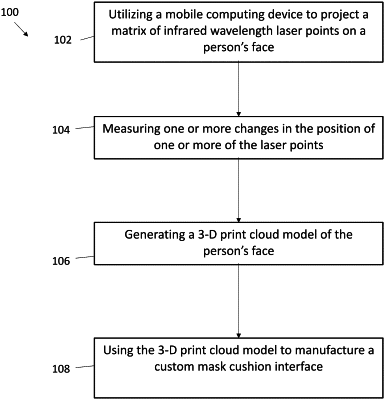| CPC G06T 7/521 (2017.01) [G01B 11/2518 (2013.01); G06F 30/23 (2020.01); G06T 3/0075 (2013.01); G06T 3/0093 (2013.01); G06T 19/20 (2013.01); G06V 40/171 (2022.01); G06V 40/176 (2022.01); G06F 2113/10 (2020.01); G06F 2113/12 (2020.01); G06T 2207/10028 (2013.01); G06T 2207/30201 (2013.01); G06T 2219/2004 (2013.01)] | 14 Claims |

|
1. A method for producing a custom-fitted face mask, the method comprising:
utilizing a mobile computing device to project a matrix of infrared wavelength laser points on a person's face, wherein each laser point in the matrix has a corresponding initial location on the person's face;
measuring one or more changes in the initial location of one or more of the infrared wavelength laser points, thereby producing one or more measurement change values;
generating a 3D point cloud model of the person's face using the one or more measurement change values; and
using the 3D point cloud model to manufacture a custom mask cushion that is capable of integrating with a generically-sized face mask, thereby producing a custom-fitted face mask for the person's face,
wherein the using the 3D point cloud model to manufacture a custom mask cushion comprises:
generating a uniform coordinate system for referencing equivalent points on a plurality of 3D face scans, each of the plurality of 3D face scans representing a different face;
fitting the generically-sized face mask on to a 3D face scan in the plurality of 3D face scans and quantifying an amount of mismatch between the generically-sized face mask and the 3D face scan;
clustering the plurality of 3D face scans to minimize an amount of overall mismatch that would result from using a fixed number of standard-sized face masks to cover all of the plurality of 3D face scans; and
generating a set of exemplar face scans based on the clustering.
|